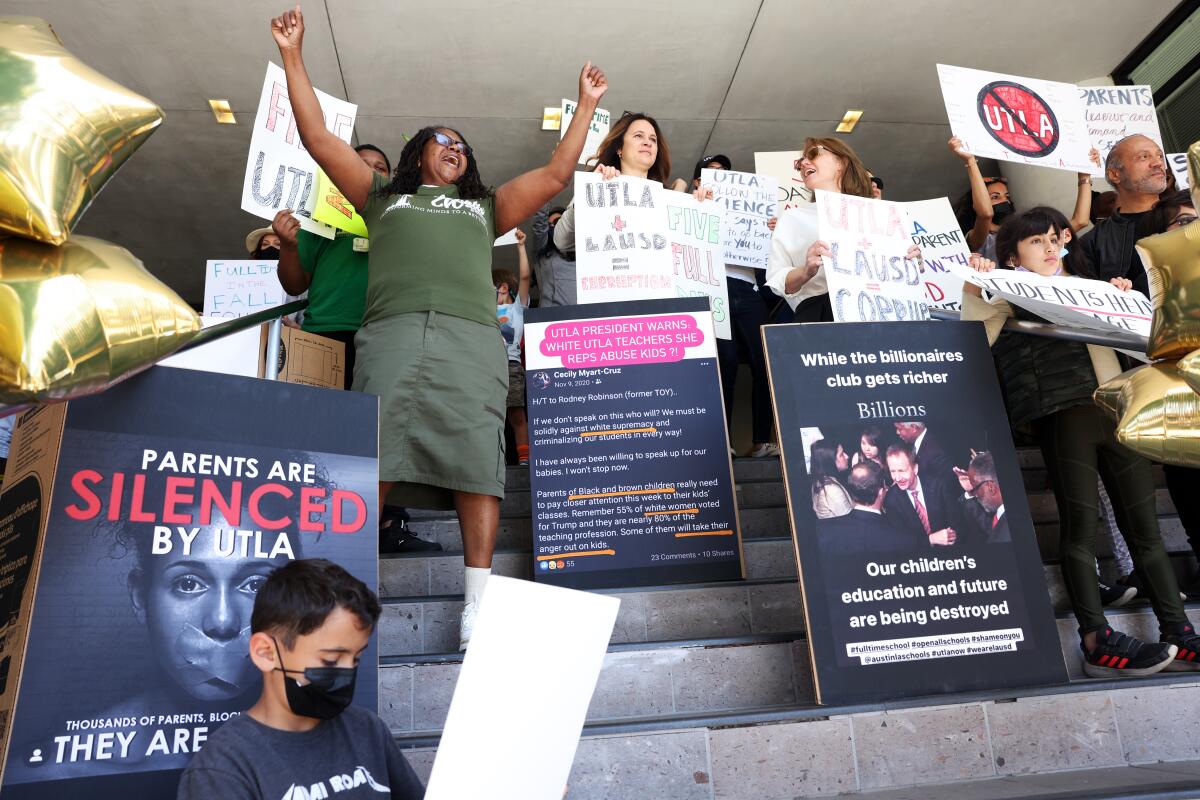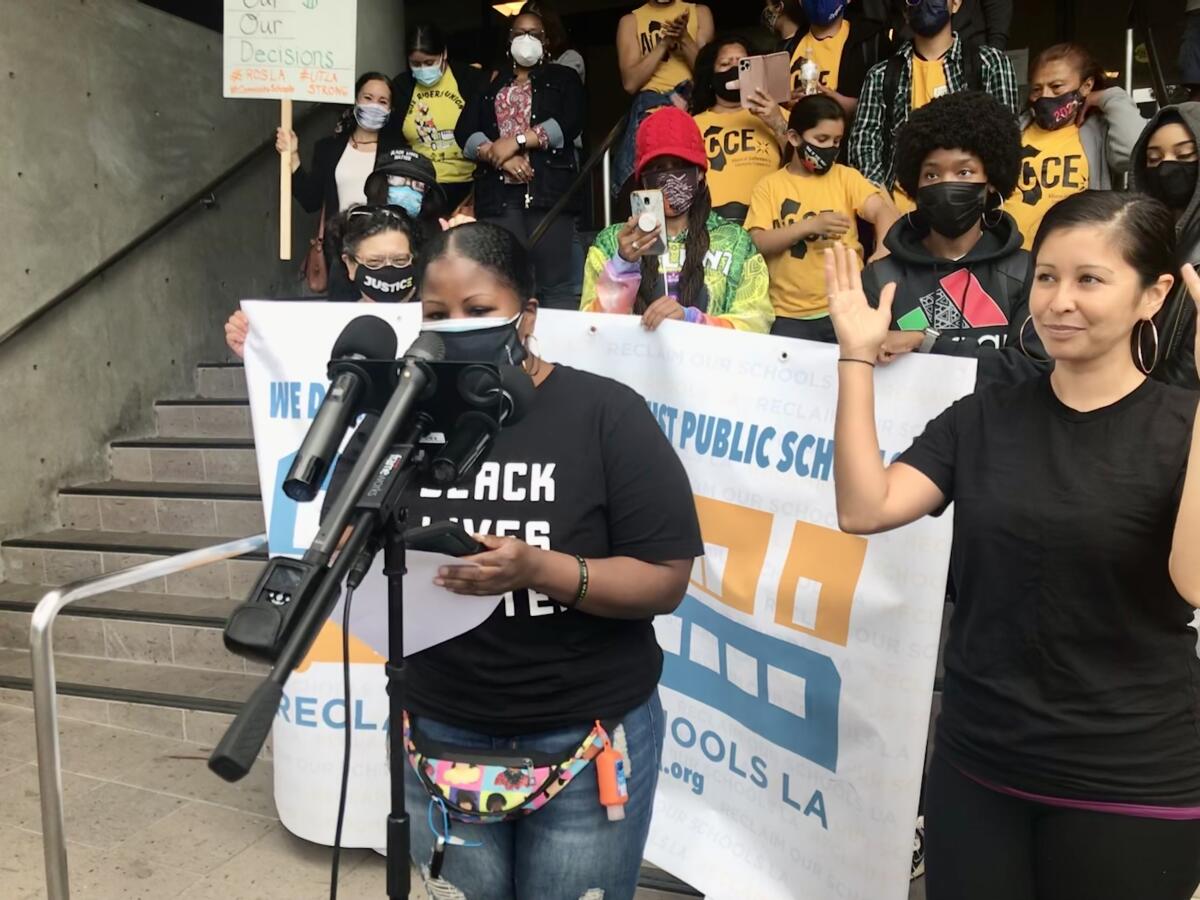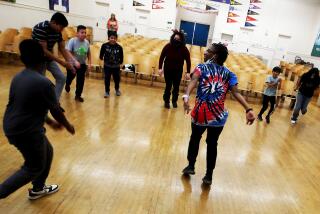What will the school year look like in the fall? The fight is on

- Share via
What schooling will look like in Los Angeles Unified in the fall will be settled over the next few weeks amid escalating demands from parents, advocacy groups and unions — all pressing their agendas for the educational recovery of some 465,000 students.
One group of parents on Sunday put their stake in the ground: They demanded that district officials commit to a normal, full-time schedule for the fall. Separately, the teachers union last week called for maintaining safety measures, hiring more union members and raising pay. Meanwhile, a coalition of community groups recently called for increased funding for schools that they identified as most in need.
In remarks broadcast Monday, L.A. school Supt. Austin Beutner indicated that schools would operate with a normal full-time schedule in the fall — even if procedures within the walls of campus were modified to maintain high safety standards.
In a rare development, money will not be the paramount problem in the short term — as billions of dollars in federal and state aid has poured into the nation’s second-largest school system. But the need is also great, and such amplified funding seems unlikely to be maintained — underscoring the stakes in the decisions now being made.
A parents group with about 70 participants rallied Sunday at school district headquarters, just west of downtown, and then marched about 2.5 miles west to the headquarters of the United Teachers Los Angeles union.
In interviews, they blamed the teachers union for not prioritizing the on-campus education of their children and the school district for not standing up to union demands.
They were angry that district officials delayed the reopening of campuses until teachers and other school employees had the opportunity to achieve maximum immunity through COVID-19 vaccinations — an approach health officials did not require. Campuses opened on a staggered basis starting the week of April 12.
Many school districts opened campuses sooner than L.A. Unified. Others followed a similar timeline, and a few will not reopen campuses at all during the current school year except to a limited population of students with special needs.
“I support unions; I support teachers,” said Joel Delman of West Adams, who has boys in seventh and 10th grade who have shown signs of depression. “But what has happened this year has been a disaster and my eyes were opened up to the fact that that disaster is due to the collusion between UTLA and our LAUSD board, which is supposed to represent parents but doesn’t listen to parents at all.”
Parents within this group are involved in litigation intended to force campuses to open more fully. With the school year scheduled to end on June 11, many are shifting their focus to the fall.
“There is no reason for them not to announce full time in the fall,” said Ghazal Yashouafar, a parent of three from West Los Angeles. “What are they waiting for?” she said.
State rules are likely to work in her favor.On June 30, temporary laws related to the COVID-19 pandemic will expire — and school districts will have to offer a full-time, on-campus schedule to qualify for full state funding.
Nonetheless, negotiations continue between L.A. Unified and United Teachers Los Angeles, which represents more than 30,000 teachers, counselors, nurses and librarians. In remarks broadcast last week on social media, union President Cecily Myart-Cruz called for salary increases and the hiring of 1,000 new teachers as well as similar numbers of new counselors. For the sake of stability, she said, no teachers should be displaced from a school.
Myart-Cruz called for spending “in a racially just, educationally just way,” adding, “the funding is there if we fight for it.”
Parents and students in the Reclaim Our Schools coalition, which is allied with the union, took part in a May 13 rally, also at district headquarters. Participants said they prioritize safety over other issues related to reopening. Many remain unconvinced that campuses are safe.
Jan Williams, whose son is enrolled at Dorsey High and has remained in distance learning, said she is concerned “because of the conditions the schools were in before they even shut down — the overcrowded classrooms. The bathrooms didn’t have hot running water.... They didn’t have soap in the bathrooms most of the time. That’s not a way to be COVID safe — if they can’t properly wash their hands.”

District officials have said they’ve doubled custodial staff — in part by hiring outside contractors — to keep schools safe during the pandemic. But separately, they’ve also said that typical school staffing before the pandemic was less than half the industry standard needed to maintain campuses properly.
Districtwide, about 30% of elementary school students have returned to campus; 12% of middle school students; and 7% of high school students. The secondary-school format was a factor in the low numbers — because students returning to campus have to remain in one room, where they log into classes, just as they were doing from home.
Hamilton High 10th-grader Maleeyah Frazier, who spoke at the Reclaim Our Schools rally, said that making schools safe for her would include the full elimination of the school police department, with those and other resources deployed instead to help students of color, LGBTQ students and Muslim students.
She added: “We deserve a chance to come back to school with mental health support after not just a devastating COVID pandemic, but also other racial and justices that students have been going through.”
Parents with other groups have spoken against ending funding for school police.
At that same spot in late April, students and parents also took part in a rally organized by a different coalition — one that included the groups InnerCity Struggle, Advancement Project California, Community Coalition and the Partnership for Los Angeles Schools, which manages 19 L.A. Unified schools with about 14,200 students.
These groups lobbied the district to more than double the amount set aside for campuses based on a formula that ranks the needs of schools. The formula incorporates such measures as community gun violence and asthma rates.
A board majority this month approved a resolution securing the requested funding — $700 million — for schools using this formula.
L.A. schools Supt. Austin Beutner, who is stepping down in June, said he supported the equity goals but objected to the hastiness of the action.
More to Read
Sign up for Essential California
The most important California stories and recommendations in your inbox every morning.
You may occasionally receive promotional content from the Los Angeles Times.












